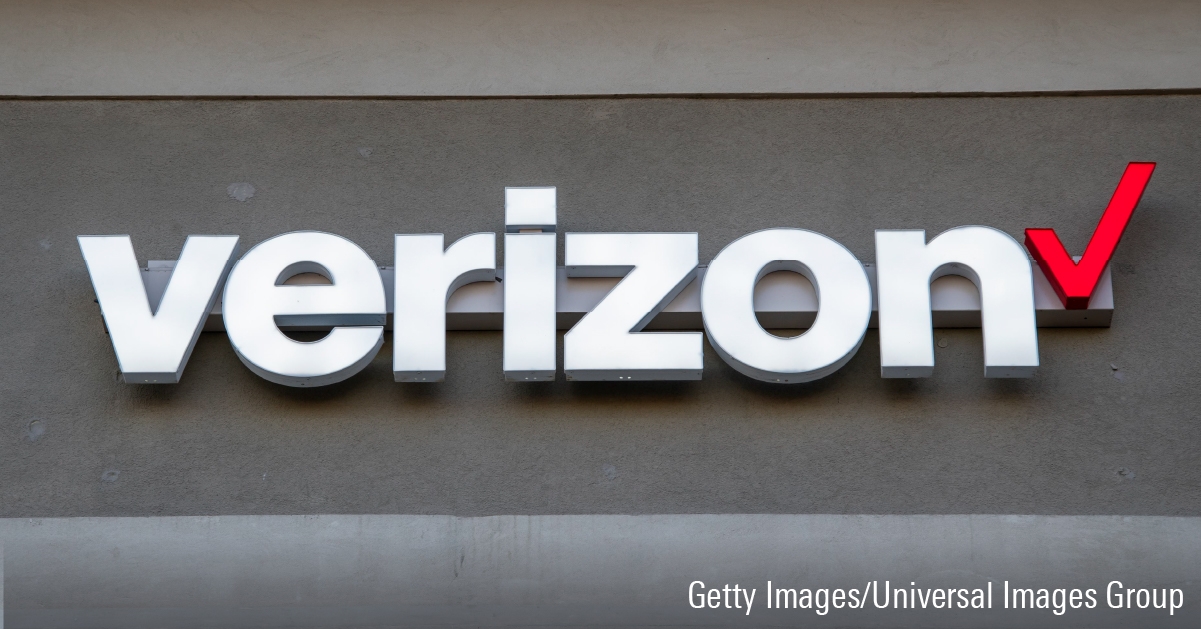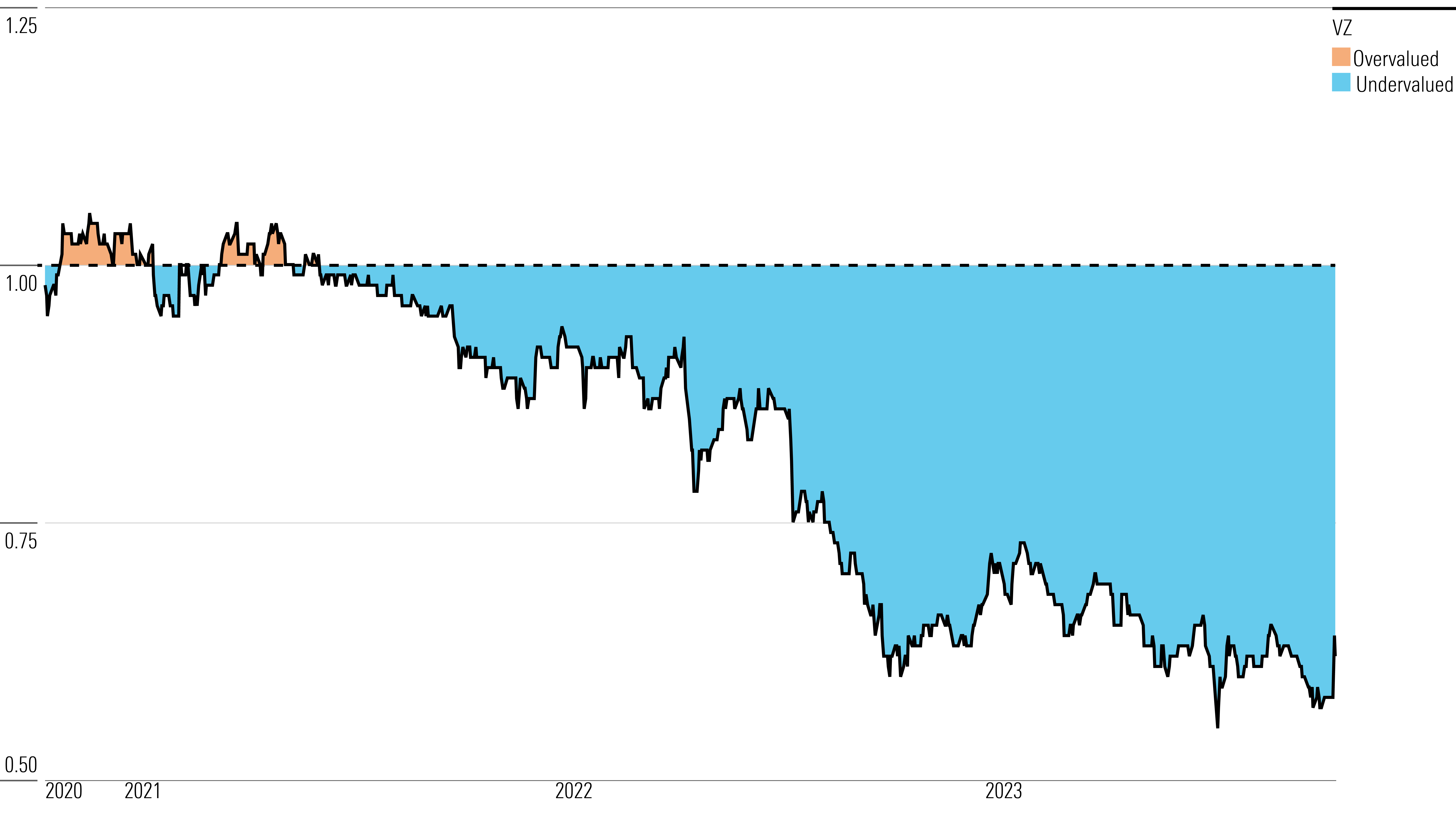After Earnings, Is Verizon Stock a Buy, Sell, or Fairly Valued?
With an improved outlook for cash flow, the dividend is looking attractive.

Verizon VZ reported earnings on Oct. 24. Here’s Morningstar’s take on Verizon’s results and the outlook for its stock and dividend.
Key Morningstar Metrics for Verizon
- Fair Value Estimate: $54.00
- Morningstar Rating: 5 stars
- Morningstar Economic Moat Rating: Narrow
- Morningstar Uncertainty Rating: Medium
- Forward Dividend Yield: 7.72%
What We Thought of Verizon’s Q3 Earnings
- The major components of Verizon’s earnings were broadly in line with expectations. The firm posted a small increase in its postpaid phone customer base: 100,000 net additions during the quarter versus 468,000 at AT&T T and 850,000 at T-Mobile TMUS. Verizon is the largest carrier in the United States, but we expect it will steadily but slowly lose market share in the coming years because its network and marketing capabilities are very similar to AT&T and T-Mobile. Most of Verizon’s wireless service revenue growth came from price increases and the adoption of higher-end rate plans.
- The biggest surprise in the quarter was free cash flow. Verizon has already generated more cash flow thus far in 2023 than it did all of last year. Management raised its free cash flow forecast for the year to at least $18 billion from more than $17 billion.
- Two smaller areas were surprising. The core residential fixed-line business added 50,000 net new broadband customers, its best result in two years. The FiOS fiber network is attracting customers despite the growing availability of fixed-wireless broadband services, including Verizon’s own offering. However, fixed-line enterprise solutions revenue declined sharply during the quarter, about 8%. This segment has struggled for years and shows no sign of improvement.
- The improvement in free cash flow is a key element of our thesis. We believe an increasingly rational competitive environment provides Verizon and its peers with the ability to maintain discipline on pricing, promotional efforts, and capital spending budgets, which should fuel expanding cash flow over the next couple of years. As investors gain comfort with Verizon’s ability to generate cash flow, the dividend starts to look really attractive.
- Even with the stock up on earnings, Verizon’s dividend yield is still nearly 8%. The dividend should consume about 60% of free cash flow in 2023 and less than that in 2024. Cash flow in excess of the dividend will be used to repay debt rather than refinance it at today’s higher interest rates, improving financial strength.
Verizon Communications Stock Price
Fair Value Estimate for Verizon Stock
With its 5-star rating, we believe Verizon’s stock is undervalued compared with our long-term fair value estimate.
Our $54 fair value estimate equates to roughly 8.1 times our 2023 EBITDA forecast. Our valuation also implies an 8% free cash flow yield in 2023 based on management’s forecast for the year. Free cash flow should increase roughly 25% for the year thanks to sharply lower capital spending as the bulk of the C-band wireless spectrum deployment effort wraps up.
We expect management will remain focused primarily on the higher end of the market, but Verizon will also likely use a variety of prepaid brands to attract customers, creating the potential to upsell them to a core postpaid offering. We also expect Verizon will benefit from an increasing number of nontraditional devices on its network, like cars and edge computing data centers. In total, we expect 2% average wireless service revenue growth annually from 2023 through 2027, with a very gradual acceleration over the course of our forecast (excluding 2023, which will benefit from a shift in the allocation of regulatory recovery fees to service revenue).
We expect consumer fixed-line revenue will grow 1% annually through 2027 as Fios continues to attract customers, broadband pricing power remains strong, and the television and phone businesses continue to decline. We aren’t as optimistic about fixed-line business services segment, but we believe this business can return to growth over the next several years as Verizon increasingly ties these services into its enterprise 5G wireless offerings and expanded fiber network.
Read more about Verizon’s fair value estimate.
Verizon Historical Price/Fair Value Ratio

Economic Moat Rating
We assign Verizon a narrow Morningstar Economic Moat Rating, stemming from cost advantages in its wireless business and the industry’s efficient scale characteristics.
Verizon has reorganized its business along customer lines, but we still believe it is best understood along wireless and fixed-line dimensions. The wireless business produces about 70% of service revenue but contributes nearly all of Verizon’s profits.
Verizon’s fixed-line operations are challenged on a stand-alone basis, in our view. These businesses account for a bit more than 20% of the firm’s invested capital base but had been operating at a loss leading up to Verizon’s segment restructuring. We believe Verizon has pursued a rational strategy for this business, spinning off or selling assets where it had no plans for future investment while investing heavily in the remaining operation.
Additionally, Verizon serves large enterprise and carrier customers around the world. The firm is reasonably well positioned in this market thanks to its global reach and deep technical capabilities. Few other telecom firms can meet the complex networking needs of larger customers, and the players in this market have been consolidating in recent years (including CenturyLink’s merger with Level 3 into a firm now known as Lumen). Verizon also acquired XO Communications in 2017, adding metro fiber rings in 45 of the 50 largest U.S. markets. These networks will help Verizon better serve business customers while also providing a platform to increase the density of its wireless network. This last point is particularly important, as we expect fixed-line networks will play an increasing role in meeting wireless capacity needs.
Read more about Verizon’s moat rating.
Risk and Uncertainty
We assign Verizon a Medium Morningstar Uncertainty Rating.
Verizon primarily faces regulatory and technological uncertainties. Wireless and broadband services are often considered necessary for social inclusion, in terms of employment and education. If Verizon’s services are deemed insufficient or overpriced, especially if in response to weak competition, regulators or politicians could step in.
Also, regulators control wireless spectrum licensing, which creates opportunities to influence the wireless industry. A flood of new spectrum available could drive down prices, further easing entry into the wireless business. Or, as we suspect was the case in the C-band auction, the threat of entry could drive up the prices Verizon feels compelled to pay.
Verizon has been a leader in deploying the latest network technologies and has the resources to make major investments, which we think will insulate it from unexpected changes in the future. Still, wireless technology continues to evolve, enabling more spectrum to be used more efficiently. Technology could eventually lower barriers to entry for firms that have long wanted to enter the business. The large cable companies, in particular, have already deployed Wi-Fi networks broadly throughout their networks to provide limited wireless coverage. Technology could quickly enhance these efforts.
Read more about Verizon’s risk and uncertainty.
VZ Stock Bulls Say
- A focus on network strength over the past 15 years has put Verizon in an enviable position. Its wireless network provides the broadest coverage in the industry, and its reputation with customers is sterling.
- With the largest customer base in the U.S., Verizon Wireless is the most efficient carrier in the industry, delivering far better profitability than its rivals.
- Verizon is relentlessly pushing forward in its core business, expanding its fiber-optic network and deploying 5G wireless technology.
VZ Stock Bears Say
- Wireless technology is dramatically lowering the cost to build and maintain a network. Rival carriers, especially T-Mobile, are rapidly deploying new spectrum and technology to add coverage and capacity. Verizon’s network leadership is a thing of the past.
- Verizon’s fixed-line business is a disaster, earning minimal profits and facing years of high costs supporting declining businesses.
- Verizon’s balance sheet isn’t the fortress it once was. Paying down debt will limit strategic flexibility and shareholder returns. Liabilities tied to lead-sheathed cable could add another headache.
This article was compiled by Brendan Donahue.
The author or authors do not own shares in any securities mentioned in this article. Find out about Morningstar’s editorial policies.

/s3.amazonaws.com/arc-authors/morningstar/12c6871b-2322-44d8-bd98-0437fa1a0a07.jpg)
/cloudfront-us-east-1.images.arcpublishing.com/morningstar/ECVXZPYGAJEWHOXQMUK6RKDJOM.jpg)
/cloudfront-us-east-1.images.arcpublishing.com/morningstar/KOTZFI3SBBGOVJJVPI7NWAPW4E.jpg)
/cloudfront-us-east-1.images.arcpublishing.com/morningstar/V33GR4AWKNF5XACS3HZ356QWCM.jpg)
:quality(80)/s3.amazonaws.com/arc-authors/morningstar/12c6871b-2322-44d8-bd98-0437fa1a0a07.jpg)